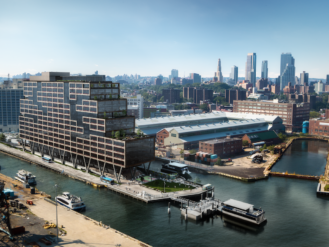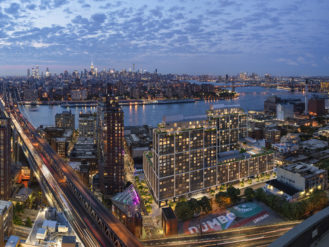As Brooklyn Towers Reach for the Sky, How Big Is Too Big?
The proposed project for 80 Flatbush would provide housing and schools, but critics point to 'unprecedented scale' near row houses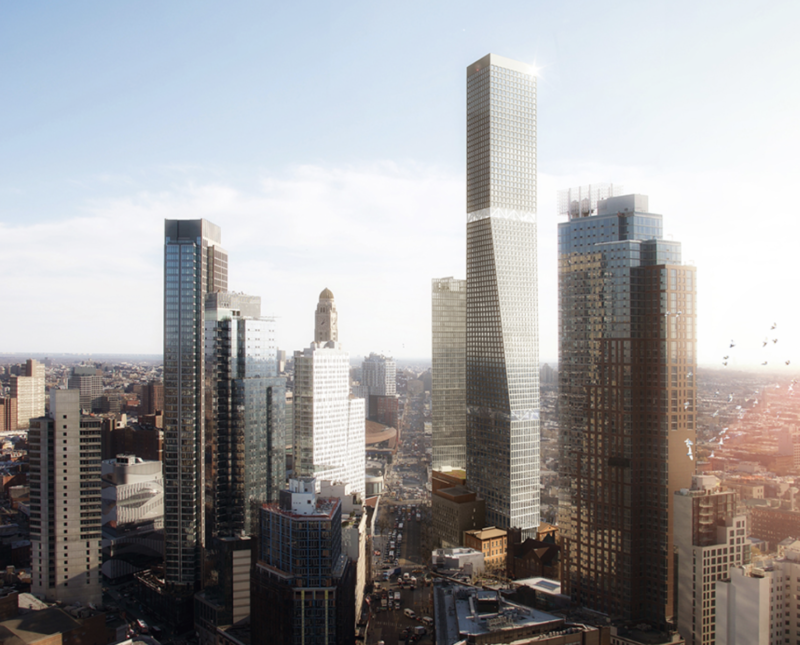
The 74-story tower at 80 Flatbush would be 50% taller than the current tallest building nearby (Renderings courtesy of Alloy Development)
As Brooklyn sprouts a towering skyline of its own, with a new project around every corner, the question keeps coming up: how big is too big? And the follow-up question is never far behind: can developers, community members and public officials reach a happy medium on that issue?
A new test case for both questions is at hand: 80 Flatbush, a two-tower, five-building project containing two schools, office space, and apartments priced at both market and affordable rates. The complex, with towers reaching 74 and 38 stories, is proposed for an irregular block not far from Brooklyn Academy of Music and the Atlantic Terminal Mall (and its transit hub below).
At that spot, 80 Flatbush could serve, as the Downtown Brooklyn Partnership CEO Regina Myer has suggested, “as an exciting southern entryway to Downtown Brooklyn.” Certainly the borough has a need for all that the complex contains, from housing to schools. Alarmed neighbors, however, especially those on row-house State Street south and west of the 1.4-acre site, prize their neighborhood scale, and say the “over-loaded” plan ignores context. In protest, the Boerum Hill Association launched a petition that now has more than 900 signatures. Their slogan: “No Towers Over Brownstone Brooklyn.”
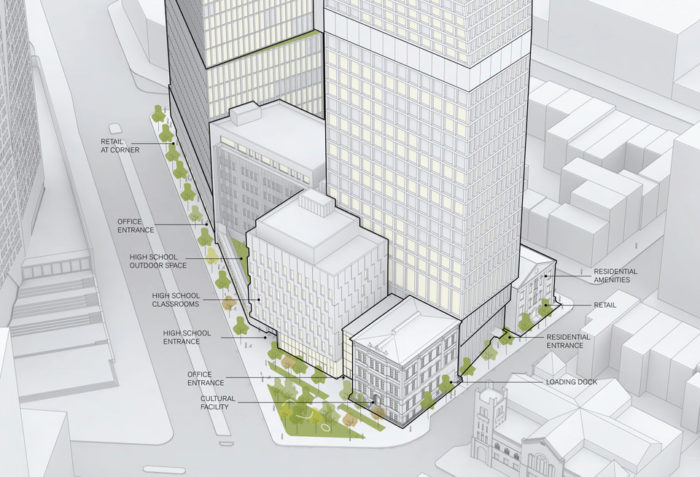
The complex would include two schools and the adaptive reuse of two historic buildings
Without asking for any zoning changes, developers could put up a significant building of up to 400 feet, “as of right” in legal terms. But 80 Flatbush, with its towers rising 560 feet and 986 feet, would contain 1.1 million sq. ft. of floor area, or 2.8 times the as-of-right scenario. A rezoning would nearly triple the site’s Floor Area Ratio (FAR), which assesses bulk as a multiple of the lot size, from 6.5 to 18, what critics have called “unprecedented” development density in their neighborhood. So 80 Flatbush poses enduring questions about the benefits and burdens of building big.
The debate is about to begin in earnest. Approval—or modification of the plan—will emerge in the city’s Uniform Land Use Review Procedure (ULURP), which launched Feb. 26 with the issuance of the Draft Environmental Impact Statement (EIS). Public hearings before Brooklyn Community Board 2 and Borough President Eric Adams will presage votes by the City Planning Commission and City Council.
“This is an exceedingly complicated project,” Council Member Stephen Levin, whose district contains the site, told The Bridge, “because it’s trying to do a lot on a very small portion of land” in what he calls a “transitional block,” including but not limited to Downtown Brooklyn.
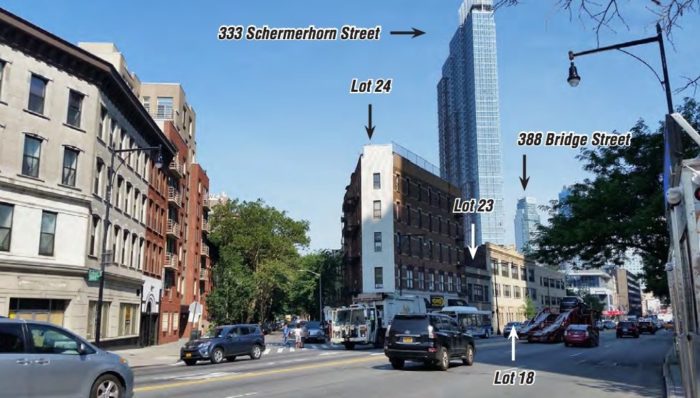
The project site, with the building at 333 Schermerhorn St. in the background (Photo from Draft EIS)
The developer, along with city officials, calls it purely Downtown. “We feel like we have a civic responsibility to leverage this transit-rich location in Downtown Brooklyn to address the housing crisis and provide essential infrastructure,” stated Jared Della Valle, founder and CEO of Alloy Development, the company selected to build the project. Alloy says the project will provide $230 million in public benefits, but the deal’s financial specifics, such as lease terms, remain under wraps.
Aiming to Rally Community Support
Alloy, which is building the complex in partnership with the New York City Educational Construction Fund (ECF), has launched a campaign to win over the community, touting benefits both substantial and symbolic. 80 Flatbush would bring up to 922 units of housing, including 200 permanently affordable to low-income households, reflecting Mayor Bill de Blasio’s Mandatory Inclusionary Housing requirements. The project would replace the Khalil Gibran International Academy, which offers bilingual English-Arabic instruction over five obsolete buildings, with a new 350-seat high school, and add a new 350-seat primary school. The schools would come at no cost to the city, in a school-starved area.
The taller tower, an extruded-looking rectangle with a narrowing taper, would help redefine Brooklyn’s skyline. It would be nearly twice as tall as the Williamsburgh Savings Bank (now called One Hanson Place), for decades the borough’s tallest building. The project would deliver retail and office space, plus a 15,000-sq.-ft. cultural facility, the latter in one of two renovated historic buildings.
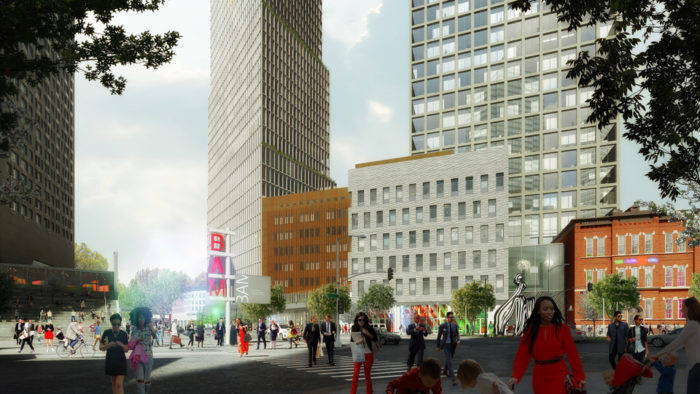
The site for the new complex is across Flatbush from the Brooklyn Academy of Music and the 300 Ashland development
Meanwhile, the long-standing retail and government functions at the site–including a pawnbroker and a welfare office for people with HIV/AIDS–would most likely be upgraded to match the sleek retail surfacing nearby, including an Apple Store and the city’s first Whole Foods 365, both in the wedge-shaped 300 Ashland complex across Flatbush. (The New York City Human Resources Administration office will move to Bushwick later this year.)
Thus the proposal from Dumbo-based Alloy, best-known for moderate-scale projects like the award-winning One John Street in Brooklyn Bridge Park and the Dumbo Townhouses, has drawn support from the Brooklyn Chamber of Commerce, Transportation Alternatives, the Brooklyn Hospital Center, the property-services union and the cultural organization BRIC, among others.
The city’s process promises more debate than, say, the failed lawsuit aimed at two new towers at Brooklyn Bridge Park’s Pier 6, which challenged the park’s governing General Project Plan. Or the redevelopment of the former Long Island College Hospital campus in Cobble Hill into large towers, which is proceeding as-of-right after a standoff between developers and the community over a plan that would have brought even more density (but also affordability).
The Local Pushback
While development at the site is likely inevitable, and it has the merit of proximity to mass transit, Alloy hasn’t won over some elected officials or the main civic group representing neighbors, the Boerum Hill Association (BHA). They point out that 80 Flatbush would be more than 50% taller than Brooklyn’s current tallest building, the 610-ft. 333 Schermerhorn St., also known as The Hub, an apartment slab halfway around the block.
The skyline’s still growing. A 720-foot condo tower, Brooklyn Point, is rising at City Point, near Junior’s Restaurant up Flatbush Avenue. And a narrow 1,066-ft. “supertall” is under construction at 9 DeKalb Avenue, near City Point. But 80 Flatbush would deliver more than double the bulk of that tower.
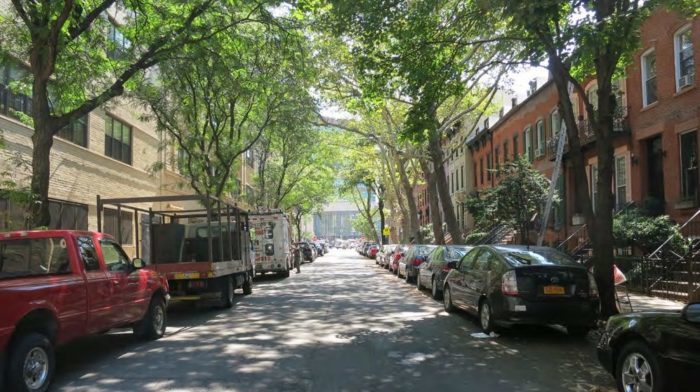
The buildings along State Street opposite the site are generally low-rise townhouses (Photo from Draft EIS)
After the project was announced in April 2017, neighbors launched their organized opposition. “The Boerum Hill Association has always advocated for intelligent growth,” president Howard Kolins said in comments to the Educational Construction Fund regarding the project’s environmental review, citing “24-story buildings” on Livingston Street and “12-story buildings” closer on Schermerhorn Street. (Then again, The Hub suggests that template isn’t sacrosanct.)
State Senator Velmanette Montgomery and Assembly Member Jo Anne Simon, in a joint letter, called the density “unprecedented” and protested that this was less a school project than a “mixed-use, commercial and residential development with a small element of educational space.” Community Board 2 Chairperson Shirley McRae also called it unprecedented because it would’t respect a buffer zone between Downtown and Boerum Hill in the way that the 2004 downtown rezoning did.
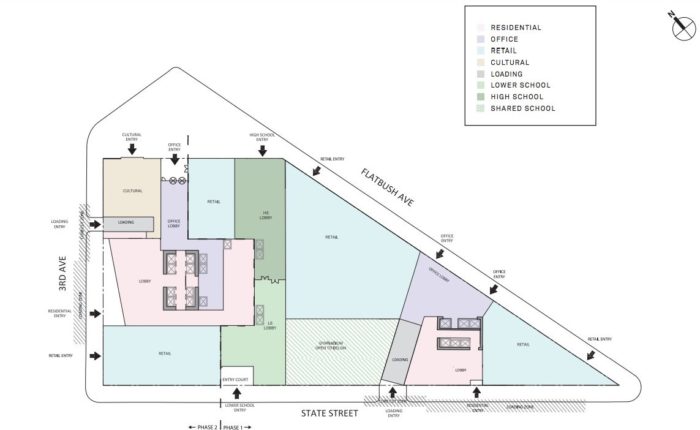
The ground-floor plan for the complex, which includes multiple buildings, new and old
But given the city’s housing shortage, planners are starting to tip toward denser development. The influential Regional Plan Association has called for lifting longstanding limits on residential bulk, calling the current density cap arbitrary, thought its report focused on sites that already allow high rises larger than what’s currently permissible at 80 Flatbush.
The Council Member’s Caution
The letters of support Alloy posted on the 80 Flatbush website are aimed neither at Community Board 2 nor state officials but rather Council Member Levin, the key public official assessing the project, since fellow Council Members typically follow the local representative.
Levin seems open to some trade-offs; he recognizes that the Khalil Gibran school is obsolete, with no gym or auditorium, among other deficits, and that the Downtown Brooklyn rezoning delivered new residents but not schools to support them. Still, he noted that the city chose not to rezone the block in 2004 to accommodate the growth being sought today.
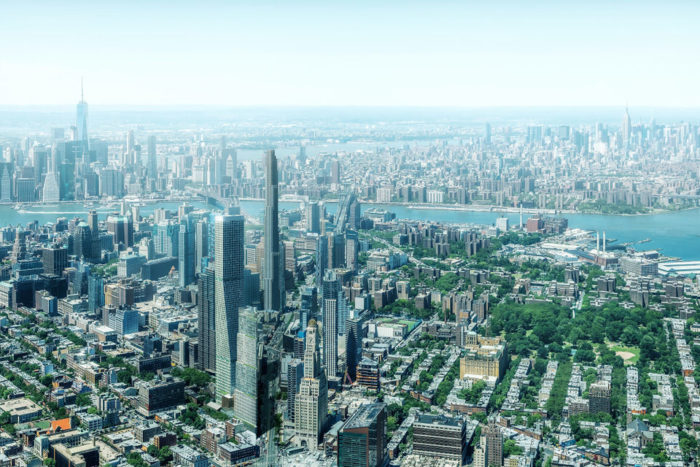
In this rendering, the supertall tower under construction at 9 Dekalb Ave. (80 feet taller) has overtaken the proposed tower at 80 Flatbush (to the left), but that one has more bulk
The debate turns partly on how one defines the neighborhood. Alloy says 80 Flatbush “is located in Downtown Brooklyn,” as does the Draft EIS. Then again, the Special Downtown Brooklyn District designation acknowledges a border zone, aiming to “provide a transition between the Downtown commercial core and … lower-scale residential communities.” Meanwhile, a New York Times Real Estate section map and the 2004 book Neighborhoods of Brooklyn put this block just within Boerum Hill’s boundaries.
“The question is: does this set a precedent for Downtown Brooklyn?” Levin said, pointing to a posture in which the city, after learning the unintended consequences from its 2004 rezoning—apartments rather than office space, and no schools—tries to make up for its past by building even bigger. The Council did recently approve an rezoning for apartments and office space at 141 Willoughby, at a higher density than the 2004 rules, though Levin suggests that the site is more clearly in Downtown Brooklyn and notes that the density approved is less than sought by 80 Flatbush.
Tweaks in the 80 Flatbush Plan
On Feb. 13, Alloy released new images, announcing that, after meetings with community stakeholders, it had modified the project. The wedge-shaped, 38-story Phase 1 tower, sited along Flatbush, was slimmed, with new setbacks along State Street to present a friendlier face to neighbors.
Alloy, two of whose principals are architects, responded to criticism of the original all‐glass façade, swapping in a masonry façade, echoing the iconic bank tower nearby. “With the bulk of the proposed project’s massing fronting onto Flatbush and 3rd Avenues, the proposed project would not adversely affect the urban-design characteristics of the lower-scale buildings along State Street,” the Draft EIS states.
To reduce the potential for increased vehicular traffic along narrow, row-house State Street–and also to save construction costs–Alloy seeks to waive city requirements to provide parking facilities along with the residential units. (Until 2012, the city required two parking spaces for every five units; it was then cut to one space for every five in Downtown Brooklyn.)
Thus 80 Flatbush, pronounced the New York Post, “has changed considerably.” By contrast, the neighborhood association’s Kolins expressed appreciation for the changes, but called them “minor,” as “density, bulk and height remain unchanged.” Community Board 2, circulating the new images, skeptically asked, “Where did all the cars go?”
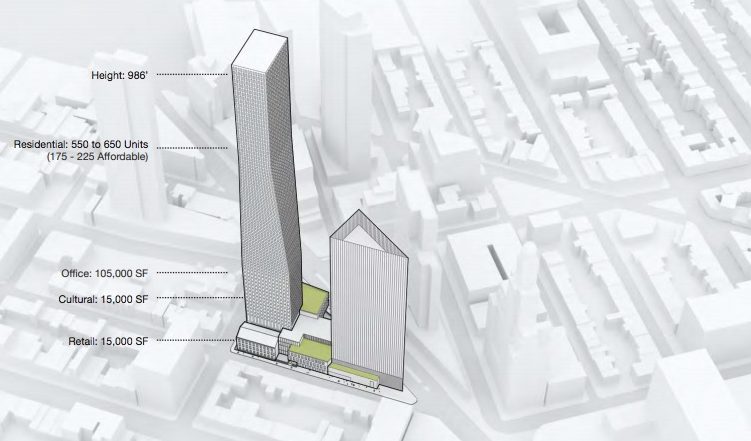
The taller structure would be completed in phase two of the project
Indeed, residents worry about traffic, not just deliveries along narrow State Street, but also an already overcrowded Third Avenue. “There’s some complicated logistics,” observed Levin.
The Draft EIS acknowledges “significant adverse vehicular and pedestrian traffic impacts at several locations,” but says nearly all could be mitigated thanks to standard measures like changes in signal timing traffic lanes. It acknowledges that shadows from the towers could significantly affect the BAM South Plaza and a community garden, but suggests some vegetation might be changed.
Also, nearby neighbors might face significant noise, but “to eliminate all unmitigated significant adverse impacts” would make it impossible to realize the project’s ambitious goals: “to increase school capacity and improve school facilities, and to further the goals of the comprehensive development plan for Downtown Brooklyn, the City’s affordable housing plan, and the Brooklyn Cultural District.”
“Is this project trying to accomplish too many things?” Levin mused. “That’s unresolved at this point. How much development is needed for the project to be financially viable?”
Support and Concern
Alloy has gained several project supporters. The grassroots Downtown Brooklyn School Solutions, which has pushed for new elementary schools, called the tradeoffs worth it: “Due to the [Department of Education’s] lack of long-term planning in Downtown Brooklyn, there are few options but to partner with the developers.” This plan, said the group, could leave money for other schools nearby.
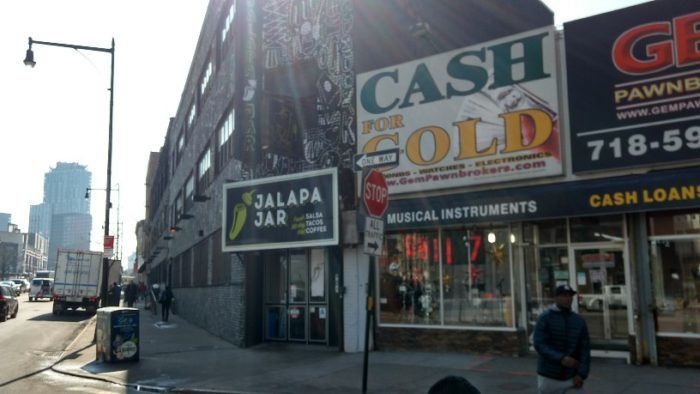
Current storefronts at the site along Schermerhorn Street, off Flatbush Avenue, with mural by Katie Merz at left (Photo by Norman Oder)
Focusing on elementary school seats, Alloy notes that, compared with the smaller, as-of-right potential project at the site, which wouldn’t include a school, 80 Flatbush would deliver 350 elementary school seats while adding only 186 more elementary school students.
Despite those increased seats, however, Subdistrict 3 of Community School District 15, which extends south through Gowanus and Carroll Gardens to Red Hook, would still have a net deficit of 3,371 seats by 2025, according to the Draft EIS. The District 15 Community Education Council suggests that the project sponsors provide substantially more primary-school seats (750 to 1,000) and warned that “creating a school utilized primarily by one block of residents exacerbates” equity issues.
Alloy’s willingness to pursue adaptive reuse of the two historic buildings on the site got kudos from Peg Breen, president of the New York Landmarks Conservancy last year. Still, a letter from the Conservancy cited by the Boerum Hill Association also urged the developers to consider concerns about “excessive height and density.”
For their part, the nearby Park Slope Civic Council and Prospect Heights Neighborhood Development Council have warned about what the latter called a “dangerous precedent,” which could ease a similarly dense two-tower project floated for a Pacific Park parcel on Flatbush, currently home to the big-box stores Modell’s and P.C. Richard.
Shaping the Debate
Alloy, perhaps taking a cue from developers like Two Trees Management with its Domino Sugar factory redevelopment, has made community-friendly gestures: a residency for artists via BRIC; rent-free space for Recess, which runs an artist-led diversion program for court-involved youth; a jazzy new mural along Flatbush Avenue; and a rent-free spot (in a former check-cashing space) for breakfast-taco joint Jalapa Jar.
Such gestures, though, don’t address scale. Levin said he expects answers to emerge during the public review and that he has asked Alloy “to make the application as flexible as possible.” For Alloy’s part, spokesman James Yolles said the firm appreciates Levin’s “thoughtful engagement and feedback,” and looks forward to working with him. Citing the “unparalleled access to transit and its prominent location on Flatbush Avenue,” Yolles added, “We strongly believe the proposed density and height is appropriate for the site.”
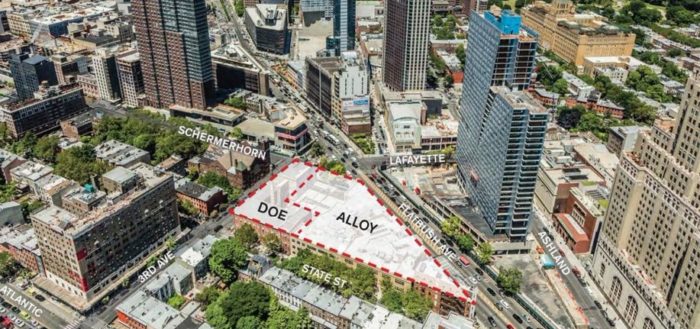
The site of the project on an irregularly shaped block, viewed from above (Illustration from NYC DOE/ECF)
At a City Planning Commission meeting Feb. 26, Commissioner Cheryl Cohen Effron raised questions about delaying the arrival of the affordable-housing units to the completion of the second tower, according to Politico Pro, but was told that the first tower’s revenue would pay for schools. “I think there’s a very large question hanging out there,” added Commissioner Anna Hayes Levin, according to that report, “about whether this is an appropriate density to put next to historic districts.” (The historic district is nearby, but below Atlantic Avenue.)
Council Member Levin recalled the 2015 approval process regarding the Brooklyn Heights Library site, wherein the city similarly aimed to leverage the library building’s air rights to stimulate development. Near the end of the process, Levin announced belated support for that project, promising deeper housing affordability, additional library service, and a better return for the city. Given that pattern, 80 Flatbush likely faces some change. The question is how much.






